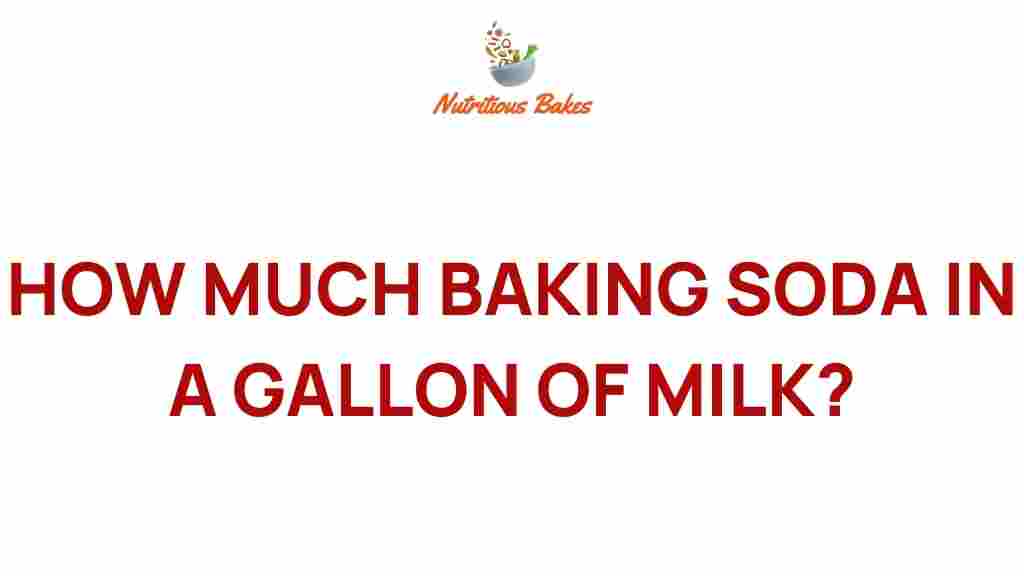The Surprising Science: How Much Baking Soda in a Gallon of Milk?
When it comes to cooking, the right ingredients and their measurements can make all the difference. One culinary hack that has gained attention is the use of baking soda in milk. This article will explore the science behind this kitchen staple, how it interacts with milk, and provide tips for effective usage in your cooking endeavors. Whether you’re a seasoned chef or a home cook, understanding the food chemistry at play can elevate your culinary creations.
Understanding the Role of Baking Soda
Baking soda, or sodium bicarbonate, is a versatile ingredient commonly used in baking. It acts as a leavening agent, helping baked goods rise by producing carbon dioxide when it reacts with an acid. However, its use isn’t limited to baking. In fact, incorporating baking soda in milk can bring about several surprising benefits.
The Science of Acidity and Baking Soda
Milk is naturally slightly acidic, with a pH ranging from 6.5 to 6.7. When you add baking soda—which is alkaline—it neutralizes some of the acidity. This reaction not only affects the flavor but can also influence the texture and overall outcome of your recipes.
- Neutralizing Acidity: Reducing acidity can make milk easier to digest for some individuals.
- Flavor Enhancements: Alkaline milk can provide a unique flavor profile that may be desirable in certain recipes.
- Texture Improvement: It can lead to creamier textures in sauces and soups.
How Much Baking Soda Should You Use?
The question remains: how much baking soda can you add to a gallon of milk without adversely affecting its taste and texture? The general guideline is:
- 1/4 teaspoon of baking soda per gallon of milk
This measurement is sufficient to achieve the desired effects without overwhelming the milk’s flavor. However, you can adjust this amount based on your specific recipe or personal taste preferences.
Step-by-Step Process for Using Baking Soda in Milk
Here’s a simple guide on how to incorporate baking soda into your milk for various recipes:
- Measure Your Ingredients: Start with a gallon of milk and measure out 1/4 teaspoon of baking soda.
- Mix Thoroughly: Pour the baking soda into the milk and stir well until fully dissolved.
- Check for Taste: Before using it in your recipe, taste a small amount to ensure the flavor is to your liking.
- Use in Recipes: Incorporate the milk into your dishes, such as pancakes, sauces, or baked goods.
By following these steps, you can effectively utilize baking soda in your milk to enhance your cooking.
Cooking Tips for Enhanced Results
Here are some additional cooking tips to maximize the benefits of adding baking soda to milk:
- Experiment with Flavors: Try adding flavors like vanilla or cocoa powder alongside baking soda for unique recipes.
- Monitor the Reaction: If you’re using milk in a recipe that requires cooking, keep an eye on the reaction between baking soda and acidic ingredients.
- Don’t Overdo It: Too much baking soda can lead to a soapy taste, so stick to the recommended amount.
Troubleshooting Common Issues
Even with the best intentions, you might face some challenges when using baking soda in milk. Here are some common problems and how to resolve them:
- Too Alkaline Taste: If the milk tastes too alkaline after adding baking soda, try reducing the amount in future recipes.
- Curdling: If the milk curdles, it may be due to excessive heat or the use of too much baking soda. Ensure you mix well and control the heat during cooking.
- Flavor Imbalance: If the flavor is off, consider balancing it with a touch of sugar or other flavor enhancers.
Recipes to Try with Baking Soda and Milk
Now that you understand how to use baking soda in milk, here are a few delicious recipes to implement this technique:
Pancakes with Baking Soda Milk
This fluffy pancake recipe benefits from the addition of baking soda in milk:
- In a bowl, mix 1 cup of flour, 1 tablespoon of sugar, and 1 teaspoon of baking powder.
- Add 1 cup of milk (with 1/4 teaspoon of baking soda mixed in) and 1 egg.
- Stir until combined and cook on a hot griddle.
Rich Macaroni and Cheese
Enhance your macaroni and cheese with a creamy texture using baking soda milk:
- Cook 2 cups of elbow macaroni until al dente.
- In a saucepan, melt 2 tablespoons of butter, then add 2 tablespoons of flour to make a roux.
- Gradually whisk in 2 cups of milk with 1/4 teaspoon of baking soda.
- Add 2 cups of shredded cheese and stir until melted. Combine with the pasta.
These recipes illustrate how incorporating baking soda into milk can yield delightful results.
Conclusion
Understanding the culinary science behind using baking soda in milk opens up a world of possibilities in the kitchen. From improving flavors to enhancing textures, this simple addition can transform your recipes. Remember to measure carefully and experiment with different amounts to find the perfect balance for your dishes. Whether you’re making pancakes or creamy sauces, this kitchen hack can elevate your cooking game.
For more kitchen hacks and tips, check out our cooking blog for additional recipes and techniques. And if you’re curious about the science of food, visit this external resource for more insights into food chemistry.
Happy cooking!
This article is in the category Tips and created by NutritiousBakes Team
